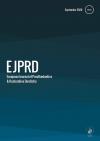European Journal of Prosthodontics and Restorative Dentistry
In Vitro Static and Fatigue Behavior of Ceramic Occlusal Veneers Using CAD/CAM
Abstract
The first and second authors contributed equally to the study and therefore share 1st authorship
To evaluate fracture resistance of occlusal veneers made of glass-ceramic and zirconia with and without fatigue. Occlusal overlays (N=80; n=10 per group) were milled out of CAD/CAM materials, namely: a)LD:Lithium disilicate glass ceramic, b)LDS:Lithium-disilicate-strengthened aluminosilicate glass ceramic, c)ZLT:Zirconium dioxide ceramic and d)ZMT:Zirconium dioxide ceramic. The overlays were cemented on polymeric duplicates, randomly distributed to aging or non-aging conditions and loaded until fracture. Ultimate catastrophic failure strength(Fmax) and Initial crack formation load(Finitial) values were analysed using two-way ANOVA. For Finitial, material type and aging and their interaction resulted in significant values (p =<0.001). Finitial mean±SD values ranged from ZMTa (593 N ±205 N) to LDSb (118 N ±42 N). As for Fmax, the material type significantly affected the outcome (p<0.001), while aging type did not show an influence (p=0.795). The non-aged Fmax specimens values presented were: LDSa (877 N ±253 N)<LDa (2029 N ±412 N)<ZLTa (2049 N ±379 N)<ZMTa (2144 N ±333 N), LDSa being significantly lower (p<0.001). The aged Fmax values were: LDSb (1313 N ±599 N)< ZLTb (1715 N ±453 N)<ZMTb (2018 N ±300 N)<LDb (2134 N ±289 N). LDS yielded significantly lower Fmax values without and non-significant less favourable results with aging. The mechanical properties following aging and lack of additional firing makes LDS an interesting restorative material for clinical application.
Keywords
Zirconia
CAD/CAM
Lithium Disilicate
Fracture Resistance
Mechanical Loading
Occlusal Veneers
Authors
Nadin Al-Haj Husain, Steven Sonderegger, Mutlu Özcan, Urs Brägger, Tim Joda
Articles from this issue
| Title / DOI | Access | Page Start | Page End | Purchase |
|---|---|---|---|---|
| The Influence of Different Designs, Materials and Cements on the Success and Survival Rate of Endocrowns. A Systematic Review 10.1922/EJPRD_1992Papia12 |
|
100 | 111 |
£10.00 |
| In Vitro Static and Fatigue Behavior of Ceramic Occlusal Veneers Using CAD/CAM 10.1922/EJPRD_2018Husain08 |
|
113 | 120 |
£10.00 |
| The Effect of Surface Pretreatment and Water Storage on the Bonding Strength of a Resin Composite Cement to Modified PEEK 10.1922/EJPRD_2060Zoidis07 |
|
121 | 127 |
£10.00 |
| Continuous Scan Strategy (CSS): A Novel Technique to Improve the Accuracy of Intraoral Digital Impressions 10.1922/EJPRD_2105Imburgia14 |
|
128 | 141 |
£10.00 |
| Minimal Data Set for Remote Clinical Consultations in Restorative Dentistry – An Exploratory Case Study 10.1922/EJPRD_1972Romano09 |
|
142 | 150 |
£10.00 |
 Free Access
Free Access No Access
No Access Full Access
Full Access


